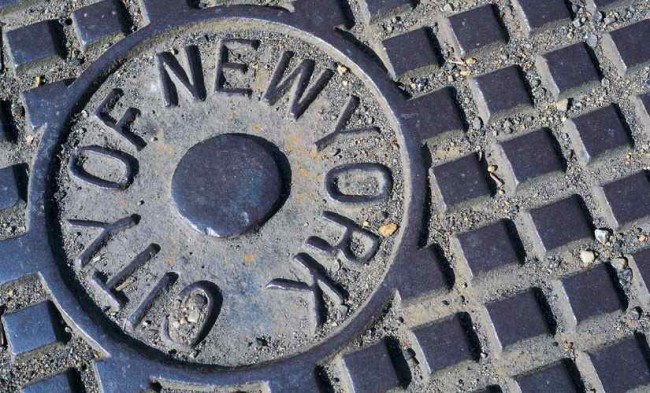
Fires Under the Street Can Send Manhole Covers Flying
Article by Frederick Fooy
Note from Editor: As I was walking home the other day along Court Street, I came across quite a site… massive smoke billowing from under a car parked at Court at the corner of Wyckoff. Everyone thought the car was on fire and a gaggle of cops and firemen showed up to get the thing under control. The sidewalk was blocked off. Turns out, it was an electrical fire under the street. The street bulged up. Everything was extinguished and all went to normal. Next day, lo and behold, our fearless city reporter Frederick Fooy, a Carroll Gardens father of two and urban planning, development and history maven, surprises me with this story. So, here you go—Lisa
The Holes in Our Streets
The infrastructure of New York City tends to be a source of frustration for most residents and occasionally a source of real danger. Winter adds additional stresses to our aging roads, bridges and subterranean features. While potholes are a common part of winter in New York, manhole fires are less common, but more disruptive. The electric grid dates from 1882 and melting snow and road salt can corrode the wires, sparking fires and the release of noxious gas. Winter is not over just yet.
Around  3 p.m. on Jan. 25, an electrical fire broke out in a manhole on Court Street between Sackett and Union. The fire was promptly extinguished by the Fire Department. In all, three fire trucks and a considerable contingent of firefighters secured the site and inspected the surrounding buildings to make sure that the fire hadn’t spread through other subterranean passageways. In this case, there were no injuries and superficial damage, but other parts of Brooklyn have been less fortunate.
On Jan. 2, a parked car was incinerated in Windsor Terrace when flames burst from a Con Edison manhole around 3 p.m. The Fire Department promptly responded with a force of 60 firefighters, but could do very little until workers from Con Edison arrived, which took another 45 minutes. By then, the vehicle was completely destroyed. A FDNY spokesman explained that power has to be shut down before the electrical fire can be extinguished, while a local resident told The Brooklyn Eagle that lights had been flickering intermittently in his home since Jan 1. On Jan. 2, the day of the street fire, the power went out as his wife was on the phone with Con Edison.
These underground fires can be wild, and occasionally dangerous to pedestrians. Avenue C in Manhattan was rocked by an explosion on Jan. 19 when a transformer blew up between East 2nd and East 3rd Streets, sending two manhole covers up into the air. The fire continued raging for 45 minutes, when the transformer finally burned itself out.
February 2 saw more than 20 students and staff being evacuated from a daycare center in Bedford-Stuyvesant after a manhole fire. Fortunately, nobody was hurt.
And on Feb. 3, a transformer malfunction on Empire Boulevard near Prospect Park led to an explosion that sent flames up from three separate manholes. According to the New York Post, U.S. Marine Nigel Edinborough had just parked his car over one of the manholes and was on his way up the stairs in his apartment building when the explosion occurred. The vehicle was destroyed.
And the list goes on. According to Con Edison, there were 65 manhole fires and explosion in New York City just between January 1 and February 4 this year.
Con Edison spokesman Chris Olert has been quoted as saying that manhole fires and explosions are caused by road salt that drains into the manholes, along with melting snow. The salt corrodes the insulation of power cables, and the cables can subsequently either catch fire or release gas that builds up and sends 300-pound manhole covers flying tens of feet into the air.
Manhole fires release carbon monoxide (CO) and other chemicals that can seep up into adjacent buildings, and dangerous levels of CO have been noticed as high as the 17th floor of Manhattan buildings located next to such fires.
Efforts have been undertaken to mitigate the risks of manhole fires. Modern manhole covers have vents to help decrease pressure buildup, and Con Edison are replacing some of its 264,000 manholes – or Utility Access Panels, as they are called nowadays – by more modern versions.
There has also been an attempt at forecasting manhole explosions. In 2004, a team from Columbia University led by Cynthia Rubin started developing an algorithm for Con Edison that would enable the power company to identify hotspots causing manhole fires. As of mid-2010, the researchers were optimistic about the possibility to predict such fires, but judging from the amount of fires in 2011 alone, this winter may have added new variables.
The Office of Emergency Management urges New Yorkers to “maintain an awareness of utilities when shoveling snow†and to not shovel snow into manholes. Meanwhile, anyone who sustains an injury or has property damaged in a manhole fire can file a claim with Con Edison.
Borough President Marty Markowitz directs Brooklynites to www.brooklyn-usa.org to report pothole problems. Click on the button “Report Potholes in Brooklyn.†The reports will be forwarded to the Community Service Center at Borough Hall for appropriate handling.
